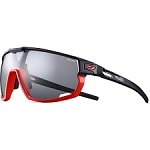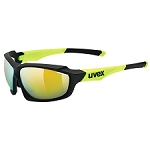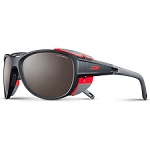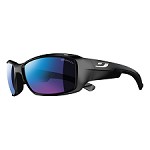The right choice of sunglasses for outdoor activities is essential for good eye health. Knowing what to take into account when choosing sunglasses for a particular activity and making sure they comply with the regulations is the first step to enjoying the best vision on your outdoor activities.

Eye protection is essential in the mountains. Photo Marc Daviet / Julbo.
In the article on UPF clothing we have already talked about the radiation emitted by the sun and the danger ultraviolet rays pose to our health. In particular, the article focuses on skin damage and the advantages of wearing clothing with a high UPF rating.
But the UV radiation does not only damage your skin. Eyes are one of the most exposed parts of the body and are highly sensitive to UV rays. In the harsh conditions of the high mountains our atmosphere offers less protection. The cellular destruction caused by ultraviolet radiation to the skin also significantly affects delicate organs such as the eyes, something that we also deal with in our article on how to choose the right ski goggles.
Ozone and oxygen in the atmosphere are responsible for blocking all UVC rays and the vast majority of UVB rays, but the higher we ascend the less dense the air becomes and protection is therefore reduced. At 2000 meters, the intensity of solar radiation is 50% higher than at sea level and over double at 4000 meters. Even infrared rays, which are usually harmless to the body, can cause problems of excessive dryness of the eyes in high mountains.

Intense radiation and luminosity in high mountains.
Snow is an added problem: snowless terrain can reflect 20% of sunlight, while the same terrain in snowy conditions reflects between 80 and 90% of sunlight. The snow acts as a mirror that reflects the powerful sunlight back towards us so it is essential to protect against this sun glare.
Sunglasses: Ignored Piece of PPE
In mountaineering we are used to personal protective equipment. Much of the equipment we use for climbing, canyoning, caving and mountaineering consists of: ropes, helmets, harnesses, carabiners, ice axes, crampons, etc. Our life depends on the these elements functioning correctly and we rely on the various norms and regulations that govern their effectiveness for our own protection.
So, you may have already guessed that sunglasses are classed as PPE, specifically a category 1 PPE and as such they have a standard that regulates their characteristics to guarantee the user that they meet all protection requirements. These technical characteristics, which have to be examined by independent certification laboratories, are contained in EN ISO 12312-1: 2013 on eye and face protection.
There are several indicators that must appear on the goggles to comply with the regulations. Apart from brand, model and the mandatory CE marking, the protection category of the goggles themselves is important and this will be discussed further on.

Indicators printed on the temple of sunglasses.
Without adequate protection, sun exposure, even if not prolonged, causes the following problems to our vision eye pain, red eyes, burns, blurred vision... in the case of more prolonged or intense sun exposure without proper glasses, the symptoms become much more numerous and serious: cataracts, photokeratitis, pterygium or blindness are some of the serious consequences associated with not wearing eye protection in bright sunlight.
But it is not only the action of the sun that can damage our eyes. When carrying out activities in a wooded environment, eyes can get hit or scratched by branches or brambles. You don’t have to be doing a fast activity such as trail running, mountain biking or ski mountaineering; if the person in front of you pushes past a small branch at the wrong time, it can swing back and hit you in the eye, causing serious damage.
Small flying insects are very annoying if they get into your eye, when running or cycling. Windy days can also drag small particles of dust or sand into the eye causing great damage if you are unable to get them out.
Luminance or Radiation Absorption
.
The advantages of glasses are clear: they protect the eyes not only from visible light, but also from invisible UV radiation, as well as proving very efficient in keeping out foreign objects. However, let's stop to further explain the difference between visible light and ultraviolet radiation and how important it is to understand the concept in order to know what we are dealing with.
We have already explained the damage UV radiation causes to our eyes and skin. We have also explained that, although they are not always related, the amount of sunlight and the amount of ultraviolet radiation we receive often go hand in hand.

Summer runs in the steppe. UV protection and protection against excessive light is necessary.
The question then arises: Do sunglasses always offer equal protection from luminosity and radiation? The answer is no, not always, and this is also dangerous when the glasses we wear in the mountains are not designed for this purpose.
Our eyes have their own defence strategies in the face of luminosity. When faced with an intense light source, the pupil contracts to regulate the amount of light entering the retina. If we wear dark glasses, with high protection against luminosity, but without adequate protection against radiation, what we are doing is forcing the pupil to dilate and allowing the entrance of dangerous ultraviolet radiation, with harmful consequences to our eyes.
The opposite can occur when wearing glasses with very clear lenses that are able to perfectly absorb all the ultraviolet radiation but allow light to pass through, leaving it up to our eyes to regulate the intensity of light we receive.
This is why it is important to know both the level of protection against luminosity and the level of protection against ultraviolet radiation. As a general rule, all sunglasses sold at Barrabes protect 100% from ultraviolet radiation.
The benefits of photochromic lenses
.
Let's recap: we already know the dangers of not wearing glasses or using glasses that are unsuitable for mountain conditions. But how dark do lenses need to be? Welcome to one of the great mountain gear dilemmas
Usually, the darker the lenses, the more luminosity they will block. You also need to consider the lens color. The most common colors for the mountains are grey, yellow and red; grey is usually associated with greater protection against bright sunlight and the correct perception of color, while yellow and brown perfectly capture the contrasts and reliefs, in addition to reducing eyestrain. Reds and oranges are mainly used for snow sports to improve the visual field.

Cebe S'Track L Pro, glasses with photochromic grey lenses.
In the mountains and high mountains, weather conditions change quickly. A mild day can change into a violent storm in a very short time, or from a sunny day to a dark, heavy sky, in a matter of minutes. How do you choose glasses with a uniform filter when the conditions are rarely constant? Even on a road through an enclosed forest where the sun's rays are filtering through, conditions are constantly changing from bright to shade.

Crossing a forest with changing light conditions.
At sunrise and sunset the sun can be blinding and yet wearing dark glasses can prevent seeing the trail clearly or finding the right holds when climbing.
.
Unstable light conditions are a constant in the mountains. Depending on the time of year, time of day, cloud cover, snow or trees or how narrow or open the path is, our vision has to adapt. Our pupils already do this quickly and efficiently, but can sunglasses also adapt?
Although sunglasses are perfect for stable weather conditions, the best way to guarantee perfect vision in the mountains is with photochromic sunglasses. The first photochromic sunglasses were made using silver chloride or similar components that darken when they receive UV rays, although technology used for modern polycarbonate goggles is different.
The darkening reaction to UV rays allows a perfect adaptability to the light conditions that we encounter and offers the best protection without hindering vision. Current models are capable of switching from one extreme to the other in approximately 20 seconds at room temperature. The application of photochromic lenses to mountain activities has been a breakthrough in comfort and protection for mountaineers.
If you know exactly which weather conditions are expected or if you do not mind sacrificing some visibility in exchange for the right protection at a cheaper price than photochromic lenses, fixed protection lenses are also a very good option.
Category and Percentage
We have previously mentioned that it is a regulatory requirement to mark the category on sunglasses. There are five categories (also known as factors) of lenses for sunglasses: from category 0 (absorbing 0 to 19% of visible light) to category 4, the highest category (absorbing 92 to 97% of visible light). In other words, category 0 lenses allow more than 81% of light to pass through, while category 4 lenses allow no more than 8% of visible light to pass through.
Lenses Categories for Sunglasses:
- Category 0: absorb 0 to 19% of visible light. Visible Light Transmission: 100 to 81%.
- Category 1: absorb 20 to 57% of visible light. Visible Light Transmission 80 to 43%.
- Category 2: absorb 58 to 81% of visible light. Visible Light Transmission 42 to 19%.
- Category 3: absorb 82 to 91% of visible light. Visible Light Transmission 18 to 9%.
- Category 4: absorb 92 to 97% of visible light. Visible Light Transmission 8 to 3%.

Bright sunlight conditions in the mountains during the winter require category 4 lenses.
The most common categories for mountain activities are 3 and 4, although category 2 is also quite useful, providing it is not used for bright sunlight on snowy terrain..
Do all high category glasses adequately protect your eyes? No, not always. The category indicates the visible light filter but tells us nothing about the protection against ultraviolet radiation.
We insist once again on the differentiation between visible and ultraviolet light. Light with a wavelength of less than 400 nanometers (UV400) is invisible to the human eye, but very harmful. The categories of the glasses do not guarantee protection against ultraviolet light, so it is important to check if your glasses have UV400 protection, before use. If you have bought your sunglasses at Barrabes, this protection is assured.
Some brands mark the percentage of filtered light. This can be useful for more demanding customers who need to know the exact lens protection, especially between categories 1 and 2. This is because there can be confusion with the range of protection; for example, categories 3 and 4 cover 15 percentage points of light filtering (between 82 and 97%) while categories 1 and 2 cover 61 percentage points (from 20 to 81%).
Indicating the percentage is very useful on photochromic glasses, where a category 1-2 lens can filter from 50 to 60% of visible light or 20 to 80% of visible light. Both lenses would be accurate indicating the level of protection, but obviously the one with the higher range would offer greater protection.
Polarized Sunglasses
The light emitted by the sun bounces off the ground and the reflection is multidirectional and rarely dazzling. However, on certain surfaces such as sheets of water (rivers, sea, lakes...) or snow or on flat surfaces such as a road, the light reflected by the sun travels towards our eyes in one direction,; this causes intense discomfort.

Uvex Sportstyle 222 Polavision polarized lenses.
To avoid this uncomfortable glare, certain glasses feature special lens treatment, such as a specifically aligned filter that prevents reflected light negatively affecting our vision. In this way, only the vertical light rays, which do not cause glare, reach our eyes, allowing us to see with more clarity and detail.
Lens Material
The most common lens materials for sunglasses are glass and polycarbonate. Polycarbonate is the most common choice for mountain activities because of its low weight and tremendous resistance to shock and impact, in addition to its relatively low cost and easy molding. Polycarbonate, unlike glass, is also able to block ultraviolet radiation. Materials such as astronaut helmet visors, spacecraft windshields and bulletproof glass are made of polycarbonate.
Glass is only rarely used today: for fashion sunglasses or glasses where exceptional quality of vision is more important than strength. This is because mineral glass, compared to polycarbonate, is more resistant to scratching and ages better.
Frame
Apart from the fashionable aspect, a basic requirement when choosing sunglasses is that they perfectly adapt to the shape of your head and face. A correct fit without oppression ensures comfort and it should not move around during activity. It is necessary to choose a size and suitable shape that adapts well to your facial profile; too close to the face can cause fogging and sweating, as well as irritating those with long eyelashes or a prominent brow, and too far away can let in light or and cause discomfort.
Proper and comfortable nose and ear support is necessary to be able to wear sunglasses for many hours, so choosing a non-slip material guarantees a better fit even when sweating.

Aerobic activities require a wrap-around design. Photo Julbo
There is a very wide variety of frames for sports eyewear. Frames made of flexible or even moldable material are best for aerobic and fast activities and more rigid frames are often chosen when the activity does not involve a high risk of falling or impact.
Half-rim frames are open at the bottom of the lens and rimless are open at bottom and top. These are excellent in extreme temperatures, since the lack of a rim improves ventilation and air flow, which prevents fogging and sweating and reduces the weight of the sunglasses to unbeatable levels. This type of frame is ideal for dynamic activities where weight is a determining factor, such as mountain biking or mountain races.

Julbo Aerolite Segment Reactiv, just 22 grams.
The classic closed frames reduce gaps between the lens and face, which makes them more resistant and they offer better protection from radiation and reflection when walking on snow. These are therefore the most suitable option for high mountain activities although, they tend to lack ventilation, so anti-fog protection is advisable if they are to be used in very cold conditions.
Regarding the fit, there is a concept called base curve that indicates the curvature of the lens and the frame. In eyewear we can find descriptions such as base curve 6, base 8... indicating that level of curvature. It is a more complicated concept in ophthalmological terms, but in practical terms for sports use, the base curve tells us how enveloping these glasses are going to be
Some glasses have flat lenses and a relatively square frame, which form and angle with the temples while others are curved and rounded. The higher the number, the more marked the curve will be and the highest number has a more wrap-around design. This information is useful for choosing according to taste but above all according to facial profiles. Glasses with a high base curve (8 and above) are more suitable for thin faces and those with a low base curve (below 8) are for wider faces.

Cebe S'Pring 2.0 Sensor Vario Rose, sunglasses with base 8 curve.
Children’s Sunglasses
We understand the reluctance of most, when it comes to buying mountain sunglasses for children. From "he'll break them or lose them" to "he won't want to wear them", the decision to invest in children’s mountain sunglasses is not taken lightly and, when it is decided, it is usually done with resignation and accompanied by serious warnings to the child about the importance of the purchase.
The importance of sunglasses for eye health is clear and no less so for children. Providing proper eye protection is essential because of what it implies in the child's development and especially because the damage inflicted by ultraviolet radiation is not only immediate but also accumulates in our cells.

It is important to get children used to wearing sunglasses from a young age in mountain environments
Both for babies and older children, the models are ultraresistant and feature lenses with a category between 3 and 4. They are made of soft, adaptable plastic, and of course, unbreakable polycarbonate lenses even for the youngest. They also include holes in the temples and an anti-loss cord. Glasses designed for babies are also usually reversible, made in one piece and therefore do not require hinges or removable elements.
We hope we have helped you with this small guide. You can take a look at the optical section of our website or visit our stores to choose the model that best suits your needs.






















Leave a comment
Be the first to comment on this article.